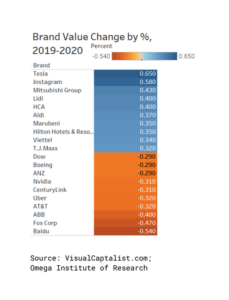- Industries
Industries
- Functions
Functions
- Insights
Insights
- Careers
Careers
- About Us
- Marketing & Advertising
- By Omega Team

Brand equity is the value your brand brings to your business. Creating and maintaining brand equity is critical to a company’s success. When a brand is associated with positive values such as high quality, integrity, and reliability, it will attract more customers and maintain long- term customer loyalty. More and more companies have realized the importance of brand value and try to create the best strategy to build powerful and positive brand equity.
Importance
Brand equity is a company’s intangible asset. A strong brand can turn into real and measurable profits. First, a positive brand can bring a competitive advantage to your product or service and therefore allows you to charge more. When a brand has a good reputation, customers will think its products are more valuable than its competitors, so the market will bear a higher price. For example, the cost of producing a piece of clothing does not vary much, but a well-known brand can sell for a higher price.
Brand value directly affects sales because customers tend to buy a product with a good reputation, even though its price is higher, its sales volume is larger than similar products. Secondly, brand value is related to customer trust. In addition to being willing to pay a higher price, they also keep their trust in the company for years and come back to buy again and again. Some companies build brands strong enough that the impact of a defective product or the occasional bad customer experience is minimized. Maintaining current customers can let the company cost less for marketing to get the same sales volume. It cost less to retain an existing customer than gain a new one.
Brand equity can also give you a considerable advantage in negotiating with vendors, manufacturers, and distributors. Suppliers are more likely to want to work with you when they realize that customers are buying your product because of your reputation. You will be placed in an enviable bargain position and may lower your costs.
Finally, positive brand equity can bring great expansion opportunities and facilitate long-term growth, which mainly reflects two aspects. By leveraging your brand, you can more easily add new products to your line, and people will be happy to try your new products. Moreover, as you expand into new markets and geographies, you are likely to connect more smoothly and quickly because people may have already recognized your brand.
How to Build Brand Equity?
Step 1: Identity
Clarify your brand identity and build basic awareness of your brand. Make sure the customers see your brand identity and perceive it the way you intend. Awareness can be enhanced by making a heartening story of your brand and stay in touch through email or newsletters, connect social media, and share content.
Step 2: Meaning
Know about your brand’s performance and imagery. Performance describes how well your product meets customer needs. Imagery refers to the social and psychological aspects of this. For example, a company that is genuinely committed to environmental responsibility will attract customers who support these values. You can develop greater brand meaning through targeted marketing. For instance, IKEA has spent money on sustainability throughout its operation: 50% of its wood is from endurable sources, 100% of its cotton is a Better Cotton Standard, and 700,00 solar panels provide power to its stores.
Step 3: Response
Customers respond to your brand through judgments and feelings. Judgments relate to a brand’s credibility, quality, relevance to demand, and superiority over the competition. Positive feelings include self-respect, trust, warmth, fun, security, social approval, and excitement.
Step 4: Relationships
The most powerful and difficult to attain in brand equity is resonance. This refers to building deeper customer relationships. Achieving this means that customers have a psychological bond and feel connected to your brand. They might feel part of a community with fellow customers and act as your brand ambassadors by joining social media conversations. Brand equity connection with customers is essential.
Step 5: Maintenance
In addition, the maintenance of brand value is a long-term task. Companies must know where their brand value comes from, and this means that brands should conduct periodic audits of their marketing efforts and customer responses. The goal is to determine whether the brand’s perception of itself and its outreach aligns with consumers’ views.
Digitizing your brand
In addition to the above branding strategies, it is worth mentioning that we must pay attention to the challenges and opportunities brought by technology and demographic changes. While millennials still make up a large portion of worldwide Instagram users, Gen Z will make up 28% of its user base in 2021, according to eMarketer projections. Baby Boomers are the biggest spenders in the United States, and Gen X is close behind, according to 2019 Epsilon research. To reach this subset of consumers, companies need to create meaningful brand stories and engage in conscious product development. A 2020 survey of Gen Z consumers from WP Engine uncovered that 82% trust a company more if they use images of real customers in their advertising campaigns. Brands that haven’t tapped into these markets have an opportunity to make a strong first impression with a new online audience.
Some companies have realized this issue and are gradually shifting their marketing targets. According to Glossy, clothing brand Chico’s has long been considered a brand for middleaged women; however, the brand has seen a 10-year drop in its average customer age in a year — a significant shift in customer demographics. The brand is ready to win over the Gen Z consumer with its timeless designs and authentic campaigns.
Along with the spread and evolution of digital technology, buying behaviors are likely forever changed due to digitization. To keep consumer loyalty and retention, today’s businesses need to optimizing digital touchpoints, which means moving away from the traditional approach of crafting content to target audiences, brands will have to look beyond their traditional targets and reach a wider range of buyers. Capitalizing on this unique time in the digital space could allow brands to fully invest in online mediums as a mechanism for mass marketing that is measurable and meaningful.
What Can We Learn From the Ranking of The Most Valuable Brands In the World in 2020?
The first figure shows how brand value is calculated and how much each industry sector and country contributes. The second chart shows the ranking of the top 10 most valuable brands in the world. The third chart shows the brand value change from 2019-2020.
With 17.5% growth resulting in a brand value of $220 billion, Amazon is a clear winner as the world’s most valuable brand, followed by Google and Apple. Amazon relies on innovative technologies and investments in fast-growing sectors, such as healthcare, to create a diverse retail ecosystem.
American retail giant Walmart enters the ranking with an impressive brand value increase of 14% to $77.5 billion. Its recent success is partially attributed to its growing strategic partnership with Microsoft. By tapping into Microsoft’s cloud services, Walmart can now provide a digital-first retail experience for its customers.
Figure 1: Brand Value Equation

Figure 2: The 10 Most Valuable Brands

Another successful example is Tesla, with an increase of 65% as the officially fastest growing brand in the world. Despite concerns over not being able to keep up with demand, the electric car company is expected to exceed 500,000 vehicle deliveries in 2020. Having recently posted over $7 billion of revenue in the fourth quarter of 2019, the success of Tesla’s innovative models are sure to rattle the automotive brands in the ranking.
However, not everything comes down to innovation. European retailers Lidl and Aldi have seen a growth of 40% and 37% respectively and are only getting started.
Figure 3: Brand Value Change by %, 2019-2020

On the other hand, some well-known brands are struggling to maintain their brand equity. Boeing’s recent hardships reflect the volatile nature of brand value. After a year of intense scrutiny following the 737 crisis, its value dropped by 29%. Following repeated safety failures, Uber lost its license to operate in London, causing a 32% decrease in its brand value. While 244 brands in the entire ranking have increased their brand value year-over-year, another 212 have taken a hit. A brand is the sum of manage reputation, customer loyalty, and awareness. Any problem of these things could trigger a chain reaction, negatively impacting a brand’s bottom line.
From the above information, we can know that even if a brand is a leader in a certain sector, a certain region, or even the world, they still face the risk of being surpassed or knocked out. Good strategies and cooperation can greatly increase its value, at the same time negative events can also bring unexpected shocks. In a word, brand equity is extremely important for any business, because, in the world of brand, competition is fierce, if you don’t keep paying attention to it, then you will probably be eliminated from the market.
Subscribe
Select topics and stay current with our latest insights
- Functions